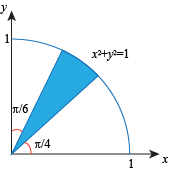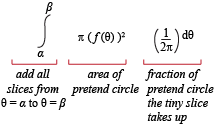Slicing Cold Pizza
First, let's forget about calculus and use our knowledge of fractions to answer the following question.
Sample Problem
What is the area of the shaded region?

Answer.
Think of the shaded region as a piece of cold pizza. The central angle of the slice is

The central angle of the entire pizza is 2π.
This means the slice is this fraction of the whole pizza:

Since the area of the whole pizza is
πr2 = π(1)2 = π,
the area of the piece is
 .
.
We can use this idea to find the area of a piece of cold anchovy pizza for any pizza described by a polar function
r = f(θ).
First we slice the piece into tiny slices. The central angle of a tiny slice is Δθ.
The angle θ measures the position of a slice by its angle from the positive x-axis, going counterclockwise. If we look just at the slice at position θ, we can pretend this slice is part of a perfectly round pizza with radius f(θ).
The tiny slice would be the fraction

of the whole, perfectly round pizza. So the area of the tiny slice is approximately

Writing this a little more neatly, the π terms cancel out and we're left with

as the area of the tiny slice.
If we want to add up the areas of all the tiny slices and take the limit as the number of slices approaches ∞ to get an integral, we need to know the reasonable values of θ.
The original piece of cold pizza must go from some angle α to some angle β.
Using the values α and β as the limits of integration, the area of the original piece of pizza is

This is usually written as

Our cold, leftover slice of pizza came in handy for more than just satisfying our hunger pains at 4 AM. We used the cold slice to derive the area for a slice-like portion of a circle in polar coordinates.
When doing problems with polar coordinates, we can use the formula

All we have to do is put in the correct values for α and β and the correct function for f(θ).
We promised before, when talking about triangles, that we'd have the power to derive any area equation we could possibly need. If you forget this formula, don't panic. Just recreate it. Remember that each tiny slice is like a fraction of circle, so the area of the region is

Cancel the π's and move the fraction  in front of the integral, and there's the formula:
in front of the integral, and there's the formula:

Be Careful:
To find the area of a region in between two polar graphs, we can do it the hard way by adding areas directly. We like to work smarter instead of harder, though, by subtracting the smaller area from the larger area.